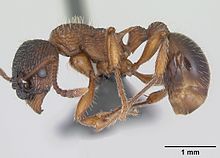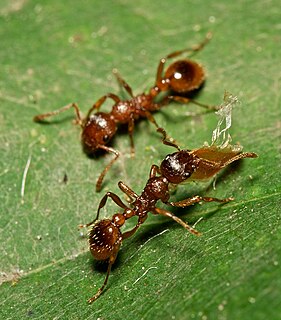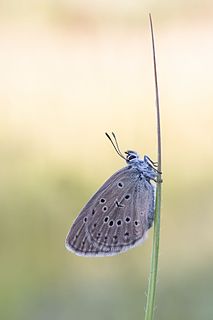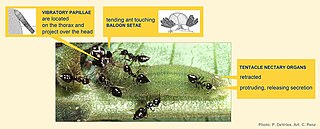| Myrmica schencki | |
|---|---|
 | |
| Worker | |
| Scientific classification | |
| Kingdom: | |
| Phylum: | |
| Subphylum: | |
| Class: | |
| Family: | |
| Subfamily: | |
| Tribe: | |
| Genus: | |
| Species: | M. schencki |
| Binomial name | |
| Myrmica schencki Viereck, 1903 | |
Myrmica schencki is a species of ant in the genus Myrmica .
| Myrmica schencki | |
|---|---|
 | |
| Worker | |
| Scientific classification | |
| Kingdom: | |
| Phylum: | |
| Subphylum: | |
| Class: | |
| Family: | |
| Subfamily: | |
| Tribe: | |
| Genus: | |
| Species: | M. schencki |
| Binomial name | |
| Myrmica schencki Viereck, 1903 | |
Myrmica schencki is a species of ant in the genus Myrmica .
Myrmica schencki is distributed across Europe (from Great Britain, Sweden, Finland in the North to Spain, Italy and the Balkans in the South), the Caucasus, Turkey, also in West Siberia, Kazakhstan, the Tien-Shan and Altai Mountains, and near Krasnoyarsk in East Siberia. It inhabits dry habitats in open areas and forests. Nests are found in the ground, occasionally in tussocks of grass or moss. Colonies are polygynous with up to 1000 workers. Recent research has shown that this species may partially feed on pollen – a phenomenon rarely documented in ants.[ citation needed ]
M. schencki is parasitized by Phengaris rebeli larvae, which release chemicals that trick the ants into believing that the butterfly larvae are ant larvae and should be brought back to the ant brood. [1] In the ant nest, the P. rebeli larvae and pupa are able to mimic the sound that the queen of the ant colony makes, causing the ants to preferentially feed the P. rebeli larvae over their own larvae. [2] While the workers are unable to distinguish the queen from the P. rebeli larvae and pupa, the queen begins to treat the P. rebeli larvae and pupa as rivals. [3] Less commonly, M. schecncki may also be parasitized by Phengaris arion . [4] Unlike P. rebeli, P. arion adopts more of a predatory relationship with the ants which is generally viewed as a less successful strategy. [5]

Ants are eusocial insects of the family Formicidae and, along with the related wasps and bees, belong to the order Hymenoptera. Ants appear in the fossil record across the globe in considerable diversity during the latest Early Cretaceous and early Late Cretaceous, suggesting an earlier origin. Ants evolved from vespoid wasp ancestors in the Cretaceous period, and diversified after the rise of flowering plants. More than 13,800 of an estimated total of 22,000 species have been classified. They are easily identified by their geniculate (elbowed) antennae and the distinctive node-like structure that forms their slender waists.

The superfamily Ichneumonoidea contains one extinct and three extant families, including the two largest families within Hymenoptera: Ichneumonidae and Braconidae. The group is thought to contain as many as 100,000 species, many of which have not yet been described. Like other parasitoid wasps, they were long placed in the "Parasitica", variously considered as an infraorder or an unranked clade, now known to be paraphyletic.

The large blue is a species of butterfly in the family Lycaenidae. The species was first defined in 1758 and first recorded in Britain in 1795. In 1979 the species became extinct in Britain but has been successfully reintroduced with new conservation methods. Currently large blue is classified as "near threatened" on the IUCN Red List of Threatened Species. Today P. arion can be found in Europe, the Caucasus, Armenia, western Siberia, Altai, north-western Kazakhstan and Sichuan.

Brood parasites are organisms that rely on others to raise their young. The strategy appears among birds, insects and fish. The brood parasite manipulates a host, either of the same or of another species, to raise its young as if it were its own, using brood mimicry, for example by having eggs that resemble the host's.

Myrmica rubra, also known as the European fire ant or common red ant, is a species of ant of the genus Myrmica, found all over Europe and is now invasive in some parts of North America and Asia. It is mainly red in colour, with slightly darker pigmentation on the head. These ants live under stones and fallen trees, and in soil. They are aggressive, often attacking rather than running away, and are equipped with a sting, though they lack the ability to spray formic acid like the genus Formica.

Phengaris alcon, the Alcon blue or Alcon large blue, is a butterfly of the family Lycaenidae and is found in Europe and across the Palearctic to Siberia and Mongolia.

Myrmica is a genus of ants within the subfamily Myrmicinae. It is widespread throughout the temperate regions of the Holarctic and high mountains in Southeast Asia.

Phengaris rebeli, common name mountain Alcon blue, is a species of butterfly in the family Lycaenidae. It was first found and described in Styria, Austria, on Mount Hochschwab around 1700. Although it was initially classified as a subspecies of P. alcon, a European researcher, Lucien A. Berger, designated it as a separate species in 1946. Genetic similarities between P. rebeli and P. alcon have led many researchers to argue that the two are the same species and differences are due to intraspecific variation.

The scarce large blue is a species of butterfly in the family Lycaenidae. It is found in Austria, Slovenia, Croatia, the Czech Republic, France, Georgia, Germany, Hungary, Italy, Japan, Kazakhstan, Mongolia, the Netherlands, Poland, Romania, Russia, northern Serbia, Spain, Switzerland, and Ukraine and East across the Palearctic to Japan. The species was first described by Johann Andreas Benignus Bergsträsser in 1779.

Rossomyrmex is a genus of slave-making ant in the subfamily Formicinae. The genus consists of four species, each with a single host from the genus Proformica, and has a very wide range of distribution from China to southeastern Spain, from huge extended plains to the top of high mountains.

Myrmica sabuleti is a species of ant in the genus Myrmica. The species is indigenous to Europe, and most colonies are polygynous. Caterpillars of the large blue butterfly parasitically prey on this ant. The caterpillar hatches on Wild Thyme buds and then at the fourth-instar stage tricks the ants into believing it is one of their own larvae. The worker ants then carry the caterpillar to their nest, where it feeds on the ant grubs for 10 months before pupating and emerging as a butterfly.
Many types of polymorphism can be seen in the insect order Lepidoptera. Polymorphism is appearance of forms or "morphs" differing in colour and number of attributes within a single species. In Lepidoptera, polymorphism can be seen not only between individuals in a population, but also between the sexes as sexual dimorphism, between geographically separated populations in geographical polymorphism and also between generations flying at different seasons of the year. It also includes the phenomenon of mimicry when mimetic morphs fly alongside non-mimetic morphs in a population of a particular species. Polymorphism occurs both at specific level with heritable variation in the overall morphological design of individuals as well as in certain specific morphological or physiological traits within a species.

Gentiana cruciata, the star gentian or cross gentian, is a herbaceous perennial flowering plant in the Gentianaceae family.

Myrmica scabrinodis is a Euro-Siberian species of ant. It lives in moderately humid habitats, tolerates soil moisture but also needs direct sunshine. It often inhabits peat bogs. It builds nests in the ground, in grass or moss tussocks, even under stones or in rotten wood. Its colonies are monogynous or have only a few queens and may contain about 2500 workers. This ant species is the main host of the entomopathogenic fungus Rickia wasmannii. Phengaris caterpillars are primary threats of M. scabrinodis with specific species such as Phengaris arion developing a predatory relationship.

Myrmica vandeli is an ant species found sporadically across several European countries. It often coexists with M. scabrinodis. It lives in open, wet meadows. Nests are typically constructed in moss pads. Polygynous colonies may contain 1500 workers. Larvae of Phengaris butterflies may parasitize their colonies.

Rickia wasmannii is a species of the widely distributed entomoparasitic order of fungi Laboulbeniales. It is an obligatory ectoparasite of ants of the genus Myrmica. The thalli penetrate outer layer of the cuticle, and appear on the host body surface. Little is known about its effect on the host ant, but it is usually regarded as a rather neutral symbiont. Contrarily, however, a recent study has documented an increased need of drinking water and a shortened life-span of infected ants.

Slave-making ants are brood parasites that capture broods of other ant species to increase the worker force of their colony. After emerging in the slave-maker nest, slave workers work as if they were in their own colony, while parasite workers only concentrate on replenishing the labor force from neighboring host nests, a process called slave raiding.

Singing caterpillars is a term coined by Philip James DeVries, referring to the fact that the larvae of ant-associated butterfly species of the families Riodinidae and Lycaenidae produce substrate borne sounds that attract ants. The study of these symbiotic associations was pioneered by Phil DeVries in Central America, and Naomi Pierce in Australia. Recently, Lucas Kaminski and collaborators are expanding the studies of riodinid-ant symbioses in Brazil.

Microdon myrmicae is a species of hoverfly belonging to the family Syrphidae.
Ichneumon eumerus is a species of parasitic wasp belonging to the family Ichneumonidae, subfamily Ichneumoninae. It is a specialist parasite of the larva of the mountain Alcon blue butterfly.